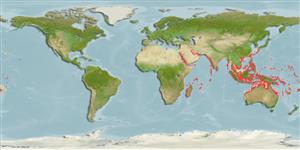>
Eupercaria/misc (Various families in series Eupercaria) >
Gerreidae (Mojarras)
Etymology: Gerres: Latin, gerres = a kind of anchovies; cited by Plinius.
More on author: Lacepède.
Environment: milieu / climate zone / depth range / distribution range
Écologie
marin; eau douce; saumâtre récifal; amphidrome (Ref. 51243); profondeur 0 - 50 m (Ref. 86942). Tropical; 32°N - 36°S, 24°E - 170°W
Indo-Pacific: Red Sea and South Africa to the Marquesas Islands, north to the Ryukyu Islands, south to Australia. Also reported from Persian Gulf (Ref. 68964).
Length at first maturity / Taille / Poids / Âge
Maturity: Lm 20.6 range ? - ? cm
Max length : 44.5 cm TL mâle / non sexé; (Ref. 90102); common length : 20.0 cm TL mâle / non sexé; (Ref. 5450)
Épines dorsales (Total) : 9; Rayons mous dorsaux (Total) : 10; Épines anales: 3; Rayons mous anaux: 7. Live specimens' head and trunk sides olive-green above, becoming silvery below; snout region blackish dorsally; dorsal fin membrane with faint black blotches or small spots at each spine and ray, just above edge of scaly basal sheath, silvery anteriorly on 1st-5th dorsal spine, grading to hyaline on spinous and soft dorsal fin; anal fin scaly basal sheath silver; distal part of pelvic fin between 1st-5th soft rays often white or hyaline for 1/5-1/3 of ray length, other parts hyaline or slightly yellowish; pectoral and anal fins hyaline. Caudal fin dusky with broad darker margin posteriorly which may be indistinct in old or poorly preserved specimens; ventral edge of lower caudal fin lobe white or bluish-white. Generally, body with prominent dark stripes along scale rows above lateral line (distinct in preserved specimens); 4-9 somewhat oblique dusky bars or columns of ovoid dark spots immediately below lateral line in specimens over 10 cm SL (dusky bars on less than 10 cm) but more apparent in preserved or stressed individuals. Scales between 5th dorsal fin spine base and lateral line 5-6.5 (modally 5.5). Upper jaw extending vertically beyond anteriormost margin of dermal eye opening, sometimes reaching to vertical at anterior margin of pupil. Second dorsal fin spine longest, 17-25% SL (Ref. 41108, 4372). Pre-opercle lower flange scaled. Body depth max 2.3-2.8 in SL. Pectoral fins reaches to or beyond level of anal-fin origin; caudal fin forked deeply (Ref. 90102). Pelvic fin of Red Sea specimens solid yellow with a narrow white distal margin; anal fin with a yellow tinge between the first rays; pectoral fin base with a dark brown spot (Horst Moosleitner, personal communication, homosub@aon.at). Examination of the meristic and morphometric data of the syntypes of G. lineolatus and G. rueppellii, and holotype of G. darnleyense showed all these are subadult or young specimens of G. longirostris (Ref. 41108).
Adults often in clear coastal waters up to about 50 m depth; juveniles often in estuaries or lagoons influenced by fresh water (Ref. 41108); they prefer shallow waters over sandy bottoms, from coral reefs to brackish waters (Ref. 30573). Fry about 10 cm in length enter the estuaries and stay until they reach maturity (Ref. 34363). Occur singly or in groups (Ref. 9710). Feed on small bottom invertebrates (Ref. 3409). In the Gilberts, the species forms spawning aggregations for a few days around the new moon (Ref. 37816). Sold fresh in markets; processed into fishmeal. Also taken with stake-nets (Ref. 3409).
Life cycle and mating behavior
Maturities | Reproduction | Spawnings | Egg(s) | Fecundities | Larves
Iwatsuki, Y., S. Kimura and T. Yoshino, 2001. Redescription of Gerres longirostris (Lacepède, 1801) and Gerres oblongus Cuvier in Cuvier and Valenciennes, 1830, included in the Gerres longirostris complex (Perciformes: Gerreidae). Copeia 2001(4):954-965. (Ref. 41108)
Statut dans la liste rouge de l'IUCN (Ref. 130435)
Menace pour l'homme
Harmless
Utilisations par l'homme
Pêcheries: commercial
Outils
Articles particuliers
Télécharger en XML
Sources Internet
Estimates based on models
Preferred temperature (Ref.
123201): 24.7 - 29.3, mean 28.5 °C (based on 3461 cells).
Phylogenetic diversity index (Ref.
82804): PD
50 = 0.5000 [Uniqueness, from 0.5 = low to 2.0 = high].
Bayesian length-weight: a=0.01047 (0.00612 - 0.01792), b=3.05 (2.91 - 3.19), in cm total length, based on LWR estimates for this species & Genus-body shape (Ref.
93245).
Niveau trophique (Ref.
69278): 3.5 ±0.34 se; based on food items.
Résilience (Ref.
120179): Milieu, temps minimum de doublement de population : 1,4 à 4,4 années (tmax=9; k=0.23-0.29; tm=1.5).
Fishing Vulnerability (Ref.
59153): Low to moderate vulnerability (30 of 100).
Nutrients (Ref.
124155): Calcium = 41.9 [19.9, 71.8] mg/100g; Iron = 0.5 [0.2, 0.9] mg/100g; Protein = 19.5 [17.6, 21.4] %; Omega3 = 0.146 [0.083, 0.247] g/100g; Selenium = 30.9 [17.0, 54.2] μg/100g; VitaminA = 72 [19, 228] μg/100g; Zinc = 1.33 [0.91, 1.87] mg/100g (wet weight);
